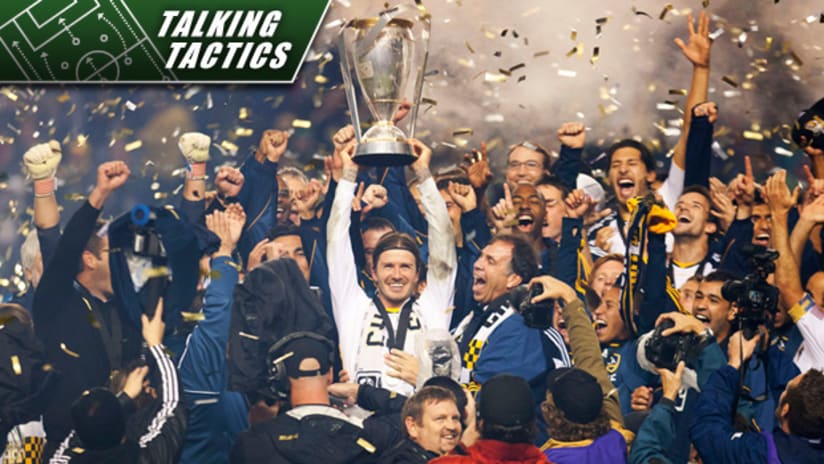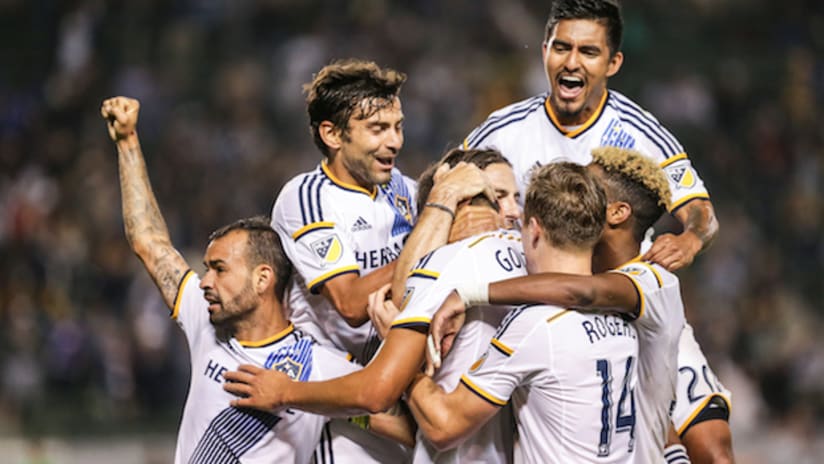CARSON, Calif. – LA Galaxy manager Bruce Arena was candid last week about the place where tactics and reality clash in important matches. The best-laid plans go straight “to hell” when the first ball is kicked, he said, and big games are a series of adjustments and counter-adjustments from there.
The Dynamo had a tactical plan going into Sunday’s night’s final. But, as Arena helped foretell, Houston just couldn’t get enough of the ball to put make the plan actionable. As a result, the Galaxy ran the show, got the goal and sprayed the celebratory champagne.
MLS Cup Recap: Donovan, LA topple Houston 1-0 for title
The Galaxy’s midfield organization and superior ability to possess the ball through the middle third was nothing short of punishing for the hapless Dynamo. That was the game in a nutshell; here’s how it broke down tactically:
Both teams played in a familiar 4-4-2, which was every bit as surprising as a referee carrying a whistle.
WATCH: MLS Cup postgame press conference

A slight difference for Houston was in Luiz Camargo’s positioning. He usually plays higher, ahead of Adam Moffat in a sort of quasi-diamond. For this one, he was slightly more side-by-side. Dynamo manager Dominic Kinnear told me later this wasn’t actually by design. Rather, the instruction was to get pressure immediately on Beckham and his Galaxy central midfield partner, Juninho.
But the Galaxy’s spacing and positioning in midfield was shrewdly spot-on. Beckham’s wily management of his starting points – remaining central and deep on an evening where a hamstring strain meant he needed to be supremely efficient in his movements – was the key. So, Moffat and Camargo spent the bulk of the match tracking and attempting to apply pressure, but frequently struggling while Beckham released balls quickly.
READ: Hamstring injury doesn't slow Beckham in Cup triumph
And while the Dynamo spent lots of energy defending and reacting, the Galaxy midfield was dictating space and pace.
LA’s midfield was the very picture of diligent discipline and organization. The Galaxy pressed as a unit, dropping into effective defensive spots and then pressing once everything was aligned, once passing lanes were accounted for. Behind them, the Galaxy back four played a high line, which effectively crammed eight defenders in an area of about 40 yards. Try getting through that – especially when your top playmaker is hurt.
Everyone knew that subtracting Brad Davis’ deadeye set pieces would dent the Dynamo attack; less talked about was how much ability to possess was lost, how mightily the Dynamo would struggle to find Carr over the top or Brian Ching’s checking runs.
The Galaxy, meanwhile, were exposing Houston left back Jermaine Taylor. When Corey Ashe moved out of defense and into Davis’ vacant left midfield spot, it left Houston effectively deploying four center backs.
Taylor was clearly uncomfortable outside. In the first half, his positioning quickly devolved into a clinic on how not to do it. He got pulled forward and away from the left center back Geoff Cameron too often, too easily. Landon Donovan’s starting positions as a Galaxy right midfielder were usually out wide, but those bright and timely dashes inside, with Sean Franklin overlapping, were a slice-and-dice for the Dynamo defense. Taylor and left midfielder Corey Ashe, having not started a match all year in that combination, simply could not communicate smoothly or sort it out quickly. That left Cameron to come over and deal with the unfolding crisis, and when center backs get pulled thusly out of the middle, bad things are never far away.
Beckham, recognizing the trouble, drifted slight right for his playmaking, although perhaps not as much as he might have normally; his relative lack of mobility made it better for him to remain central, linked to Juninho, allowing Donovan’s inside movement to fill that space in front of Galaxy center backs.
Going the other way, Taylor tried time and again to pull balls from his outside (left) foot to his stronger, inside (right) foot. That slowed down the Dynamo movement out of the back. So Taylor went even more conservative after halftime, remaining more closely linked to his other three defenders while more or less abandoning any desire to attack. Rather, he chose early, long balls toward Carr and Ching.
With Donovan tracking inside, Ashe or even Taylor had chances to break forward quickly. But after a full season in defense, Ashe’s instincts leaned overly conservative. As Kinnear said later, “he’s really a defender now.” So he missed chances to press the Dynamo attack, to apply some pressure on the Galaxy, deferring to his duty to protect Taylor.
While Taylor and Andrew Hainault made precious few offensive forays, Galaxy fullbacks Sean Franklin and Todd Dunivant, aggressive but smartly so, found attacking spots. When they did receive balls going forward, they were almost always in dangerous spots, which kept Ashe busy and further prevented him from being a bother offensively.
About the time the Dynamo began grabbing some possession, moving the game a little deeper into the Galaxy end for about 10 minutes of the second half, Arena made the change that mattered. Off came Adam Cristman, who found good striking spots but didn’t finish, and in came Chris Birchall. It’s a well-worn 60th-minute Galaxy ploy, moving Donovan up top as a change of team pace.
Birchall is more defensive, tending as always to remain wider in the attack. Meanwhile, Donovan and Keane were more closely linked, for which the Dynamo paid a fabulous price on the game’s only goal.
Kinnear had only one real option for a midfield change: Colin Clark. Kinnear could have removed Taylor and dropped Ashe to fullback, adding Clark on the left. But Danny Cruz, always a hit-or-miss type along Houston’s right side, was having one of his “misses.” So, Kinnear needed to keep the Clark card available for a change on the right.
Kinnear eventually brought on Carlo Costly for the ineffective Carr. But Costly struggled to gain the speed of the game, and he was a little redundant in his checking runs, replicating what Ching was already doing. For the game’s final 10 minutes, Cameron moved off the Dynamo back line and into the midfield in a 3-5-2. This pushed Costly higher, but still to little effect.
In the end, the Dynamo created one good offensive chance. The Galaxy created several, and only needed the one to pay off.




